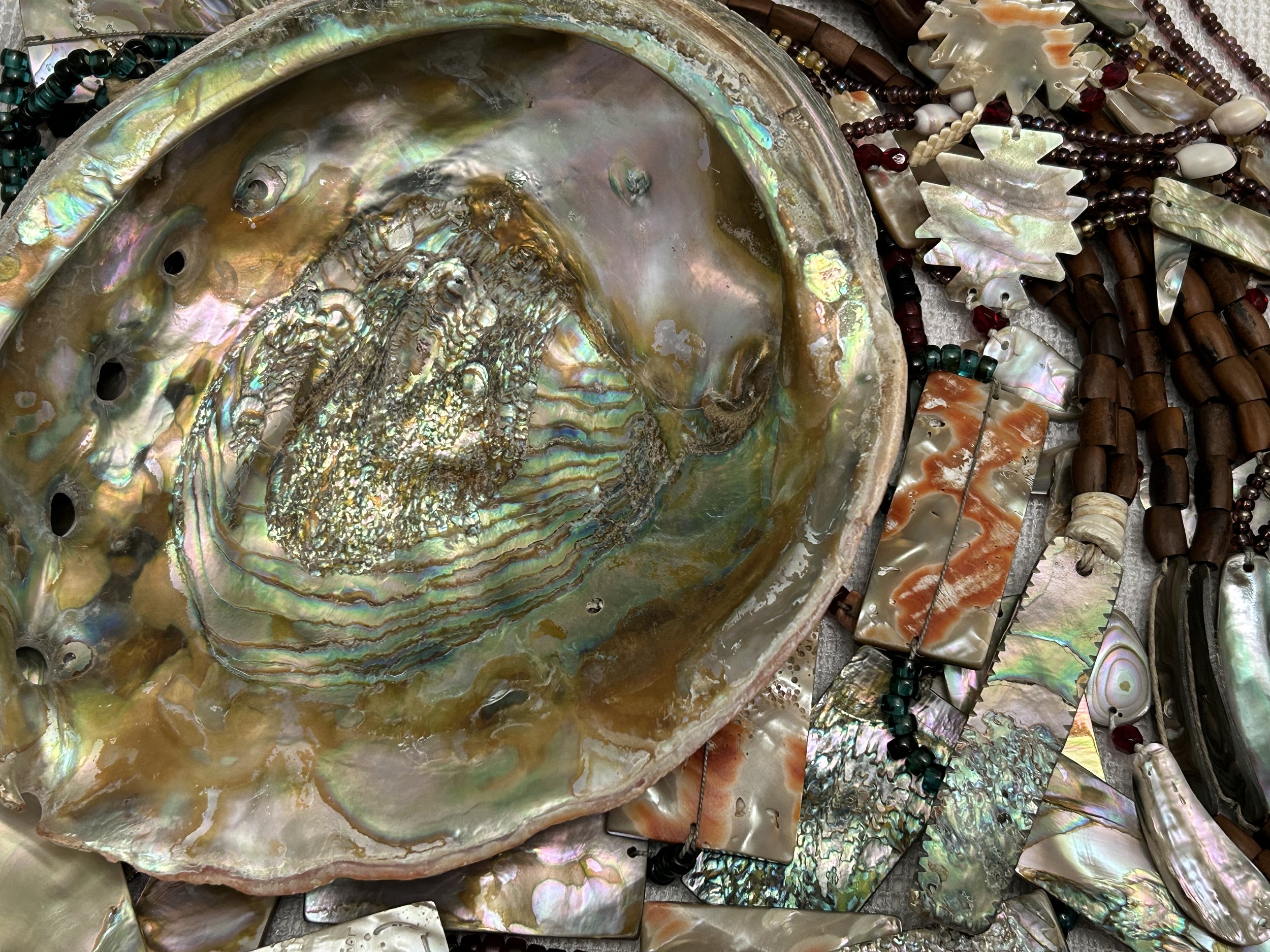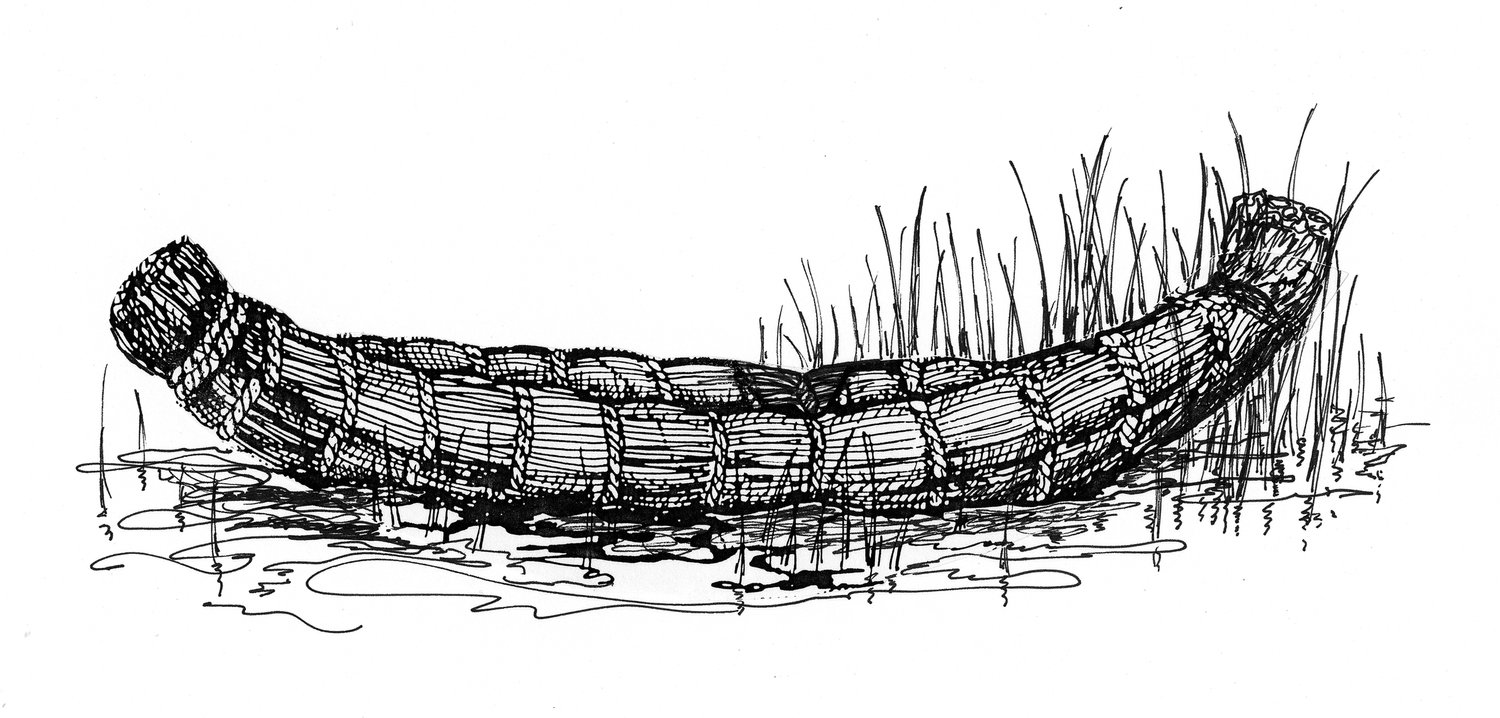
“Landscape is Homeland Festival” at the Exploratorium • Saturday, April 22, 11-5
The Exploratorium in San Francisco presents its first “Landscape is Homeland Festival,” a free outdoor event celebrating Earth Day by honoring California’s first peoples, represented by invited California Indian artists and cultural practitioners. Cultural displays, demonstrations, and hands-on activities for all ages will include traditional basketry, games and technologies, contemporary arts, and more. We hope to see you there!

Basket Mosaic a Must-See in Oakland
If you’re in the East Bay, consider swinging by East Oakland to check out this stunning 12x10-foot tile mosaic by artist Susanne Takehara, of Eastside Arts Alliance. Takehara, who wanted to feature Ohlone artistry on this building facade, reached out to Rumsen Ohlone master basket weaver Linda Yamane and the result was this beautiful representation, on a grand scale, of the intricate stitches, fine feather work, and iridescent abalone ornamentation of Yamane’s original basket.
The mosaic, installed in January 2021, is located at 1245 23rd Ave, Oakland, CA 94606. Eastside Arts Alliance office and studio is in the same building, just around the corner. Enjoy!


Aulun — Ohlone Abalone
Did you know? The word “abalone” originated from the Rumsen word for Red Abalone (Haliotis rufescens) — aulun. The Spanish colonizers adopted the word, changing it slightly to “aulón,” and later to “abalón.” You might want to Google “etymology of word abalone” for confirmation!
Monterey’s early English speakers of the 1800s also referred to abalones as “aulones.” The Monterey Weekly Herald, November 27, 1875, ran an article “The Aulone” in which it stated, in part: “… In former years the interior Indians in great numbers were in the habit of visiting the coast to gather aulone shells. They would spend months by the shore in breaking them into suitable pieces for the nose, ear and neck ornaments …”
Pry bars made of whale ribs were used by Rumsen divers to pry abalone from the rocks. Such a pry, found at Point Lobos, is in the collection of the Pacific Grove Museum of Natural History.
Frank F. Latta, who worked with many Central Valley Yokuts people, wrote: “Spangles and ornaments of various forms and sizes were made from abalone shell. I have several statements establishing the fact that they passed from person to person as money; but because of their supernatural power, they were valued so highly that such use was greatly restricted.” (Handbook of Yokuts Indians by F. F. Latta, 1949, p. 70)
The beautiful, magical iridescence of abalone shells made them valuable to our Rumsen Ohlone ancestors and to other Native peoples throughout California and beyond. The shells were shaped into pendants and beads for personal adornment and to dangle from the sides of colorfully feathered baskets.
Aulun remains precious to our Rumsen Ohlone community today. Whether as earrings or necklaces, or sparkling ornamentation on our dance regalia, we wear it proudly as a reflection of the beauty of nature and the beauty of our Rumsen culture.

Wassak Succumbs to Lead Poisoning
Sad news has come from the Ventana Wildlife Society that three-year-old Wassak (Condor 968), whose name means “condor” in Rumsen language, has died of lead poisoning. Released into the wild two years ago, Wassak had been doing extremely well until showing up at Pinnacles National Monument last month in obviously poor health. He was taken to LA Zoo, where he was diagnosed with lead poisoning. Staff worked tirelessly to try to save his life, but his condition was too far advanced and he died on January 5th. Wassak is another example of the negative impact of humans on the natural world, which in this case could have been avoided if hunters would simply stop using lead ammunition — which is now illegal in California.

250th Anniversary — Daughter of Tucutnut
Today — January 7, 2023 — is the 250th anniversary of an event that took place in our Rumsen village of Tucutnut in lower Carmel Valley. In honor of this ancestor of myself and so many others, I’ve written up as much as is possible the story of her experience, blending documented historic facts with Rumsen cultural knowledge shared by elders throughout the 19th and early 20th centuries. Please read her story — “Daughter of Tucutnut — 250 Years Later” — located in our new “Stories of Then & Now” page. (Use the “Stories” drop-down menu above.) Shuururu mak menn Margarita.
—Linda Yamane, Member of the Rumsen Ohlone Tribal Community


Wassak — Yet Another Condor Poisoned by Lead
I received an email yesterday from the Ventana Wildlife Society here in Monterey. Wassak, a three-year-old condor, was recently rescued from the wild, suffering from lead poisoning and fighting for his life. In spite of the fact that lead ammo is now illegal in California, this is not a rare occurrence.
But what is rare is that this bird’s name — wassak — means condor in Rumsen language. I was honored to provide five Rumsen names for newly-released condors in late 2019, and Wassak (#68) was one of these young condors. Now his life is in jeopardy because of lead ammunition in the dead animals he ate. For those who might want more information, you can visit the Ventana Wildlife Society’s website (ventanaws.org). The condor bios for Wassak’s cohort of seven (all with Monterey County indigenous names) have audios for pronunciation. You can always donate or join the Ventana Wildlife Society to support their ongoing efforts to introduce Condors into the wild and protect them once they’re there.
—Linda Yamane, Member of the Rumsen Ohlone Tribal Community

Solstice—Birth of a New Year
“makS etkonin pirre — the year has become new on us.” Happy indigenous new year! As the year begins anew, here’s wishing peace, good health and happiness to all.

“Are these people extinct?”
Yes, that’s what I heard a man’s voice say behind my left shoulder as I sat demonstrating Ohlone basket weaving at the Christmas in the Adobes event last Saturday evening. In all fairness, he had just entered the room and stopped at my first of three tables of cultural displays. He obviously had not yet noticed signage on the table in front of him that read: Rumsen Ohlone Tribal Community — We Are Still Here.
I was stunned to hear such a comment in the 21st century — hadn’t that notion disappeared long ago? Next, I thought an archaeologist friend must have returned and decided to play a trick on me by saying something obviously outrageous. “Ha-ha, you got me,” I thought. But when I turned toward the voice, I found that it wasn’t my friend at all, but a random visitor who sincerely wondered if the indigenous people connected to these baskets and abalone necklaces still existed.
We talked and I was able to assure him that we are not extinct — that we are still here, there are many of us, and that I had made the baskets and abalone necklaces and beautiful ear ornaments, the clapper sticks and deer hoof rattle on the tables in front of him. Our language and culture are not dead. I told him about our website — RumsenOhlone.com — where he can learn more.
His unexpected and shocking question made me realize why I had spent hours packing and setting up, had driven to downtown Monterey in a crazy rainstorm, and spent two evenings in a cold historic building instead of staying warm at home on those cold, stormy nights. If we don’t want to be invisible to the outside world, we must take time out of our busy lives to be cultural ambassadors, letting people know that, yes, we are still here, keeping our culture, our community spirit, and the memory of our ancestors alive.
—Linda Yamane, Member of the Rumsen Ohlone Tribal Community

Christmas in the Adobes
Visit us Friday, Dec. 9 & Saturday, Dec. 10, 5-9 pm, for the 2022 “Christmas in the Adobes” — Monterey State Historic Parks’ fund-raising event supporting school programming at the Pacific House in Monterey’s Custom House Plaza. We will have an extensive Rumsen cultural display and basket weaving demonstration. Hope to see you there!

